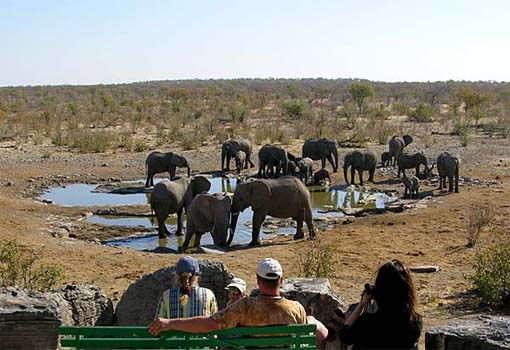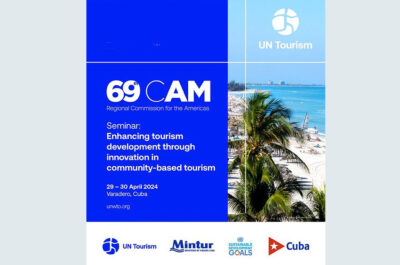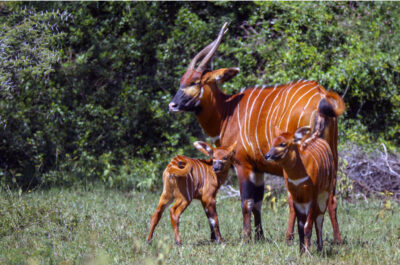
Apart from being able to see animals, many hotels, guesthouses, eco-tourism villages, and jungles have been developed in wildlife sanctuaries nearby, so people are visiting national parks and wildlife sanctuaries for relaxation instead of the hustle and bustle of city life; this is creating lucrative opportunities for the global wildlife tourism market.
The global wildlife tourism market size is expected to reach US$ 219.9 Billion by 2032. The wildlife tourism market is growing rapidly as the COVID-19 effect has reduced significantly.
As per FMI Analysts, the global wildlife tourism market is estimated to be valued at US$ 135 Billion in 2022 and is projected to increase at a CAGR of 5% in the forecast period from 2022 to 2032.
Tourists, who notice that their entry fees are invested in the conservation of species, are willing to re-visit wildlife sanctuaries and are prepared to pay additional fees just to ensure animal life preservation. Besides simply watching wildlife, visitors are aware of different fauna and flora species, which drives the growth of the wildlife tourism market.
Apart from being able to see animals, many hotels, guesthouses, eco-tourism villages, and jungles have been developed in wildlife sanctuaries nearby, so people are visiting national parks and wildlife sanctuaries for relaxation instead of the hustle and bustle of city life; this is creating lucrative opportunities for the global wildlife tourism market.
Movies and other filming occur in nearby areas that attract local tourists, which creates robust development in the sector of wildlife tourism. Schools arrange trips to wildlife sanctuaries to introduce students to wildlife and flora at wildlife sanctuaries. Wildlife photographers are also drawn to visiting wildlife sanctuaries, driving the wildlife tourism sector forward.
The presence of tourists at wildlife destinations contributes to the conservation and improvement of the conditions of wild animals. Wildlife tourism aids the local tribes in improving their living standard, as when tourism flourishes, they are able to improve their standard of living by the adoption of wildlife tourism.
Although these funds are reserved for conservation programs, there are some negative impacts, too. Tourists have been known to disturb wildlife when they approach it very closely to take photographs, and also, the breeding patterns of animals may be affected by tourists constantly asking to take photos of animals in their mother’s arms.
There are many ways for tourists to see wildlife from the water, such as canoeing, kayaking, or enjoying a cruise on the river. Using local transportation, such as a mokoro, which is used in some African countries, will appeal to most travelers, fueling the demand for wildlife tourism.
Visitors to Kenya and Tanzania can experience wildlife from the skies through hot air balloon excursions. Gliders can also be used to experience wildlife close up.
The wildlife tourism market has received a lot of traction in the industry.
Due to the entry fees tourists pay which are invested in conserving animals, more and more tourists are willing to return to wildlife sanctuaries and are willing to pay extra fees just to ensure animal life conservation. In addition to merely watching animals, tourists are also aware of various fauna and flora species, and consequently are inclined to participate in wildlife tourism, which is likely to sustain the growth of the wildlife tourism market share.
Many eco-tourism villages and jungles have been developed in and near wildlife sanctuaries, attracting a large number of tourists as well as hotels, guest houses, and eco-tourism villages to the area. As a result, tourists now do not only visit national parks and wildlife sanctuaries to see animals, but they also do so for relaxation, after they have been away from the hustle and bustle of city life.
Due to better infrastructure, movie shootings also take place in nearby areas, which provide the fuel for the growth of wildlife tourism. Also, many schools organize field trips to wildlife parks to introduce students to the flora and fauna in the parks. Wildlife photographers who keep visiting the parks also play an important role in encouraging the development of the wildlife tourism market.
Tigers are an important part of many wildlife sanctuaries, and Ranthambore wildlife sanctuary and Kanha National Park in India are among the few places where tourists can see these animals up close. Many visitors are visiting these sanctuaries simply to see tigers, which is boosting global wildlife tourism.
By visiting wildlife destinations, tourists encourage the improvement and conservation of wild animals, wildlife tourism also supports the local tribes because when tourism flourishes, they have more opportunities for improved livelihoods. The constant flow of tourists discourages poachers from killing wildlife, and certain entrance fees are charged to tourists when visiting wildlife sanctuaries, creating demand for wildlife tourism.
Several wildlife sanctuaries around the globe are famous for their wildlife. These include the Lone Pine Koala Sanctuary in Brisbane, Australia, Chengdu Moonbear Rescue Centre in China, Noah’s Ark in Georgia, USA, and Corbett National Park in Uttarakhand, India.
Several wildlife sanctuaries in India and other countries are famous for their tigers. Ranthambore wildlife sanctuary and Kanha National Park in India are two of the few sanctuaries where tourists can see tigers up close. The tiger tourism market in these sanctuaries is growing and has boosted growth of the global wildlife tourism market.
Although these funds are reserved for conservation programs, there are some negative impacts, too. Tourists have been known to disturb wildlife when they approach it very closely to take photographs, and also the breeding patterns of animals may be affected by tourists constantly asking to take photos of animals in their mother’s arms.
Some of the leading companies operating in the global wildlife tourism market include Adventure Canada, Chinkara Journeys, Birding Ecotours, Echidna Walkabout Wildlife and Nature Tours, Elm Wildlife Tours, Frontiers North Adventure, Nature Trek, Oryx Worldwide Photographic Expeditions, and Rockjumper Wildlife Tours.
Most travelers prefer guided walking or cycling to be physically active while viewing wildlife, as they enjoy nature more without being distracted by the constant noise of vehicles. By doing this, tourists are able to appreciate nature even more, offering lucrative opportunities for the global wildlife tourism market.
The opportunity for tourists to experience wildlife from the sky is available in exotic locations such as Kenya and Tanzania, where hot air balloon safaris are offered. Another option is to experience wildlife from a glider, such advancements are fueling the market for wildlife tourism.
There are many ways for tourists to see wildlife from the water, such as canoeing, kayaking, or enjoying a cruise on the river. Using local transportation, such as a mokoro, which is used in some African countries, will appeal to most travelers.
Wildlife tourism is beneficial to the local tribes, as when tourism flourishes, they have opportunities to make a living, a constant flow of tourists discourages poachers from destroying endangered species of animals, and there is a fee charged for visiting wildlife sanctuaries, and this in turn has led to increased demand for wildlife tourism.
These insights are based on a report on Wildlife Tourism Market by Future Market Insights.
Vicky is the co-founder of TravelDailyNews Media Network where she is the Editor-in Chief. She is also responsible for the daily operation and the financial policy. She holds a Bachelor's degree in Tourism Business Administration from the Technical University of Athens and a Master in Business Administration (MBA) from the University of Wales.
She has many years of both academic and industrial experience within the travel industry. She has written/edited numerous articles in various tourism magazines.





























































































































































